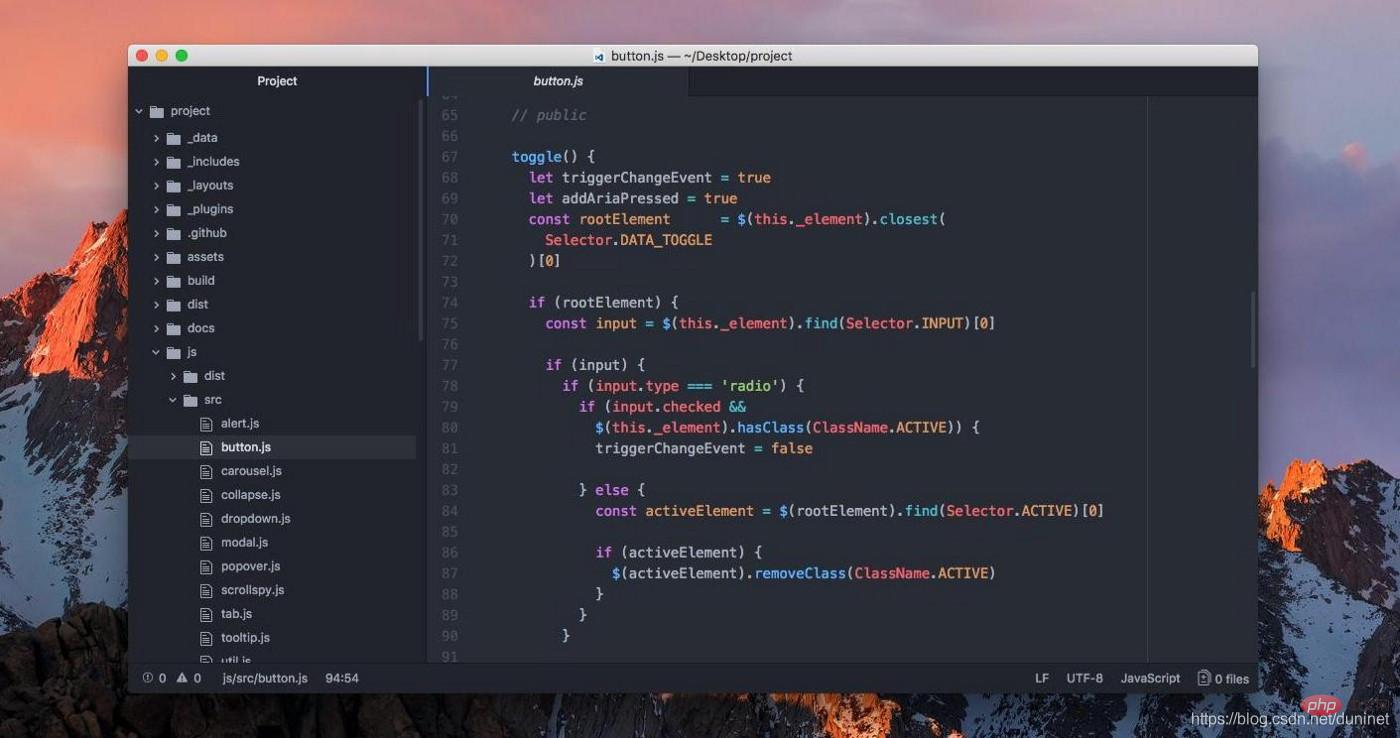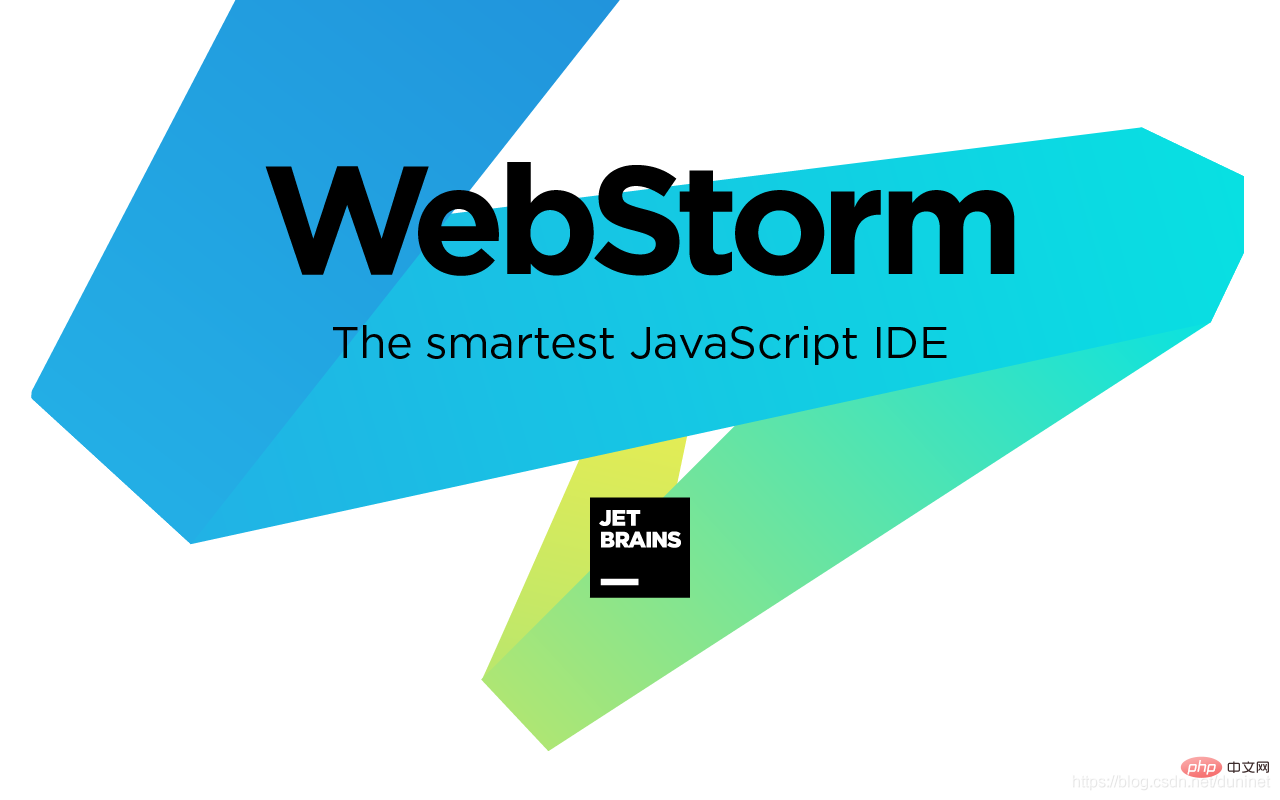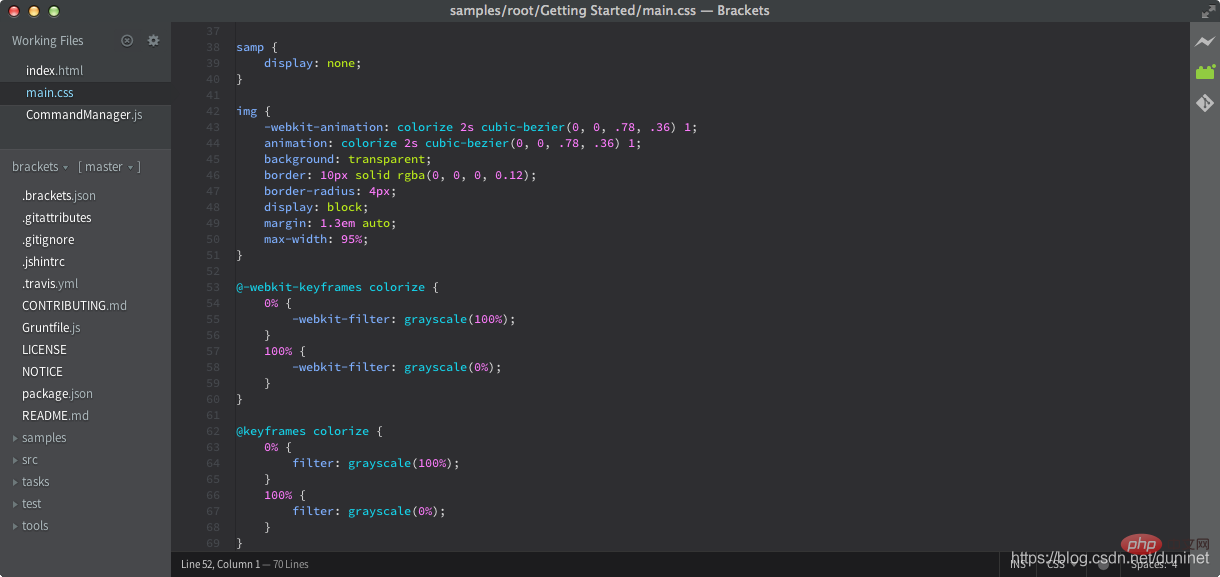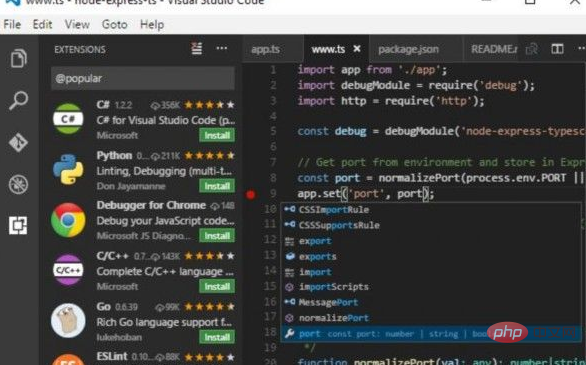Is there an IDE for javascript?
There are IDEs in JavaScript, such as Visual Studio Code, Atom, WebStorm, IntelliJ IDEA, Brackets, Microsoft Visual Studio, Komodo, etc.

The operating environment of this tutorial: windows7 system, javascript version 1.8.5, Dell G3 computer.
Integrated Development Environment (IDE, Integrated Development Environment) is an application used to provide a program development environment, generally including tools such as code editors, compilers, debuggers, and graphical user interfaces. It is an integrated development software service suite that integrates code writing functions, analysis functions, compilation functions, debugging functions, etc. All software or software packages (groups) with this feature can be called integrated development environments. Such as Microsoft's Visual Studio series, Borland's C Builder, Delphi series, etc. The program can be run independently or in conjunction with other programs. IDE is mostly used to develop HTML application software. For example, many people use IDEs (such as HomeSite, DreamWeaver, etc.) when designing websites because many tasks are automatically generated.
Every developer has his or her own favorite IDE.
How do we choose which IDE is most suitable for development? Well, the capabilities of the IDE do have an impact on this choice. But in general, it boils down to each developer's preference, which is a very subjective choice.
Let’s take a look at some of the best IDEs for JavaScript development.
1. Visual Studio Code

Visual Studio Code (also known as VS Code) is a product of Microsoft. It's important not to confuse this with Visual Studio, which is primarily for .NET development.
This is one of the best IDEs I have come across. I believe that most of you must have personal experience with this IDE. It's very powerful and feature-rich, and best of all, it's free to use.
Although most developers have probably used VS Code, not everyone knows its power. So, let’s take a look at some of them and you’ll understand what you’ve been missing out on over the years.
Visual Studio Code has
- support for multiple languages (JavaScript, TypeScript, etc.). Custom extensions can be installed here to support the ecosystem of C#, C++, Python, and more.
- Syntax Highlighting
- Autocomplete with IntelliSense
- The ability to debug code by attaching a running application and including breakpoints
- Shortcuts to Improve coding efficiency
- Marketplace with extensions to support many extra features (e.g. Docker extensions)
- Integration features with Visual Studio Code Online
- Version control via extensions
In addition, Visual Studio Code also has convenient remote collaboration functions. This is achieved through a service called Live Share provided by Microsoft. You can invite developers to work on your project together, and you can edit the same file at the same time. You can even see the other person's cursor on the file.
Isn’t it cool?
Regarding VS Code, there are also some shortcomings to pay attention to.
- If you're coding in a language other than JavaScript, you may need to spend some time and effort setting up your environment for it.
- Since it is built on Chrome, it takes up a lot of memory.
But, by the way, shortcomings aside, this is a top-notch JavaScript development IDE and you should definitely check it out if you haven't already.
2. Atom

Atom is an open source IDE that gained a lot of traction before the launch of Visual Studio Code. It is supported by GitHub, which is another reason why it has become very popular. Atom is an Electron application.
Atom is similar to VS Code in many ways. It supports Windows, Mac and Linux. It is free to use and is licensed under the MIT license. It also has features like auto-completion of code, support for multiple projects, and multi-section editing.
One disadvantage of Atom is that it is slower than VS Code. This is because Atom provides most of its functionality through extensions, rather than built-in functionality from VS Code.
But, overall, Atom is a feature-rich, customizable IDE for the 21st century.
3. WebStorm

If you have been working in the software industry for a while, there is no doubt that you have heard of IDE development company JetBrains. WebStorm is also a product of JetBrains, which focuses on JavaScript development.
It supports multiple technologies and languages, such as JavaScript, HTML, CSS, Angular JS, TypeScript, Node.js, Meteor, ECMAScript, React, Vue.js, Cordova, etc. WebStorm is compatible with Windows, Mac and Linux operating systems.
Some of the main functions of WebStorm are as follows
- Intelligent code completion
- Multi-line to-do items
- Automatic code reconstruction
- Debugger
- Syntax error detection
- Unit testing
- Use arrow functions to convert to variables
- Integration with VCS (Veritas Cluster Server)
- Parameter prompts
- Git integration
Compared with VS Code, WebStorm also has many shortcut keys, which makes coding more convenient and faster.
However, one major drawback of this IDE is that it is proprietary software and you must purchase a license to use WebStorm in your daily coding. However, JetBrains allows you to get WebStorm for free in a few scenarios, such as student packages and open source projects.
4. IntelliJ IDEA

IntelliJ IDEA is another IDE from JetBrains. It comes in two editions: Community Edition and Ultimate Edition. The Community Edition is free to use, while the Ultimate Edition requires purchasing a license.
This IDE is feature-rich, similar to all the IDEs we have talked about before. Some of its features are as follows:
- Advanced code completion
- Built-in static code analyzer
- Deployment and debugging tools for most application servers
- Test Runner User Interface
- Code Coverage
- Git Integration
- Support for multiple build systems
- Extensive database editor and UML design Editor
- Supports Google App Engine, Grails, GWT
- Smart text editor for HTML, CSS and Java
- Integrated version control
- Automatic execution Repetitive programming tasks
I think IntelliJ IDEA has two main disadvantages. The first and main drawback is that the Community Edition only supports Java and Kotlin out of the box, with few other languages as plugins. If you want to use JavaScript, you will have to opt into Ultimate Edition, which is not free. The next disadvantage of this IDE is that it comes with a steep learning curve. Therefore, if you are not familiar with IntelliJ IDEA yet, you may not learn it overnight.
5. Brackets

If you are looking for a popular IDE for web design, Brackets is your first choice. This specifically supports web design and facilitates the following points.
- A set of visual tools.
- Preprocessor support.
Similar to VS Code and Atom, Brackets is also free to use.
Compared with other editors, Brackets provides some unique features. They are,
- inline editors.
- Live Preview - Allows you to connect live with your browser; whenever you make changes, you'll see them immediately on the screen.
- Preprocessor support - This allows you to use fast editing and real-time highlighting of LESS and SCSS files.
It goes without saying that this is one of the IDEs that best supports web design and development.
6.Microsoft Visual Studio
Although Visual Studio is more suitable for .NET IDE and is not as suitable for JS as WebStorm, in general, it is a very good JavaScript IDE.

As you all know, Visual Studio is a way to quickly navigate, write, and develop apps for Android, iOS, Mac, Windows, Web, and Cloud. Fix your code for easy debugging and diagnostics, extend and customize it to your liking, and collaborate effectively.
7.Komodo
Komodo provides advanced JavaScript editing, syntax highlighting, navigation and debugging functions, but does not include JavaScript code inspection functions. For this, you can run JSHint in the shell. Komodo IDE runs on Windows, Mac OS X and Linux and supports common open source languages - Python, Perl, PHP and Ruby. The code intelligence engine is very reliable. It scans all language installations for custom extensions, such as the PEAR module. On the project side, it supports integration with CVS, Subversion, and Perforce, and also allows direct FTP transfer of code to the server.

Overall, although Komodo is not the best, it is a good enough IDE. It can publish file groups through FTP, SFTP, FTPS or SCP. You can also synchronize files and detect potential publishing conflicts with other people's changes.
[Recommended learning: javascript advanced tutorial]
The above is the detailed content of Is there an IDE for javascript?. For more information, please follow other related articles on the PHP Chinese website!

Hot AI Tools

Undresser.AI Undress
AI-powered app for creating realistic nude photos

AI Clothes Remover
Online AI tool for removing clothes from photos.

Undress AI Tool
Undress images for free

Clothoff.io
AI clothes remover

Video Face Swap
Swap faces in any video effortlessly with our completely free AI face swap tool!

Hot Article

Hot Tools

Notepad++7.3.1
Easy-to-use and free code editor

SublimeText3 Chinese version
Chinese version, very easy to use

Zend Studio 13.0.1
Powerful PHP integrated development environment

Dreamweaver CS6
Visual web development tools

SublimeText3 Mac version
God-level code editing software (SublimeText3)

Hot Topics
 1393
1393
 52
52
 1207
1207
 24
24
 How to implement an online speech recognition system using WebSocket and JavaScript
Dec 17, 2023 pm 02:54 PM
How to implement an online speech recognition system using WebSocket and JavaScript
Dec 17, 2023 pm 02:54 PM
How to use WebSocket and JavaScript to implement an online speech recognition system Introduction: With the continuous development of technology, speech recognition technology has become an important part of the field of artificial intelligence. The online speech recognition system based on WebSocket and JavaScript has the characteristics of low latency, real-time and cross-platform, and has become a widely used solution. This article will introduce how to use WebSocket and JavaScript to implement an online speech recognition system.
 WebSocket and JavaScript: key technologies for implementing real-time monitoring systems
Dec 17, 2023 pm 05:30 PM
WebSocket and JavaScript: key technologies for implementing real-time monitoring systems
Dec 17, 2023 pm 05:30 PM
WebSocket and JavaScript: Key technologies for realizing real-time monitoring systems Introduction: With the rapid development of Internet technology, real-time monitoring systems have been widely used in various fields. One of the key technologies to achieve real-time monitoring is the combination of WebSocket and JavaScript. This article will introduce the application of WebSocket and JavaScript in real-time monitoring systems, give code examples, and explain their implementation principles in detail. 1. WebSocket technology
 How to use JavaScript and WebSocket to implement a real-time online ordering system
Dec 17, 2023 pm 12:09 PM
How to use JavaScript and WebSocket to implement a real-time online ordering system
Dec 17, 2023 pm 12:09 PM
Introduction to how to use JavaScript and WebSocket to implement a real-time online ordering system: With the popularity of the Internet and the advancement of technology, more and more restaurants have begun to provide online ordering services. In order to implement a real-time online ordering system, we can use JavaScript and WebSocket technology. WebSocket is a full-duplex communication protocol based on the TCP protocol, which can realize real-time two-way communication between the client and the server. In the real-time online ordering system, when the user selects dishes and places an order
 How to implement an online reservation system using WebSocket and JavaScript
Dec 17, 2023 am 09:39 AM
How to implement an online reservation system using WebSocket and JavaScript
Dec 17, 2023 am 09:39 AM
How to use WebSocket and JavaScript to implement an online reservation system. In today's digital era, more and more businesses and services need to provide online reservation functions. It is crucial to implement an efficient and real-time online reservation system. This article will introduce how to use WebSocket and JavaScript to implement an online reservation system, and provide specific code examples. 1. What is WebSocket? WebSocket is a full-duplex method on a single TCP connection.
 JavaScript and WebSocket: Building an efficient real-time weather forecasting system
Dec 17, 2023 pm 05:13 PM
JavaScript and WebSocket: Building an efficient real-time weather forecasting system
Dec 17, 2023 pm 05:13 PM
JavaScript and WebSocket: Building an efficient real-time weather forecast system Introduction: Today, the accuracy of weather forecasts is of great significance to daily life and decision-making. As technology develops, we can provide more accurate and reliable weather forecasts by obtaining weather data in real time. In this article, we will learn how to use JavaScript and WebSocket technology to build an efficient real-time weather forecast system. This article will demonstrate the implementation process through specific code examples. We
 Simple JavaScript Tutorial: How to Get HTTP Status Code
Jan 05, 2024 pm 06:08 PM
Simple JavaScript Tutorial: How to Get HTTP Status Code
Jan 05, 2024 pm 06:08 PM
JavaScript tutorial: How to get HTTP status code, specific code examples are required. Preface: In web development, data interaction with the server is often involved. When communicating with the server, we often need to obtain the returned HTTP status code to determine whether the operation is successful, and perform corresponding processing based on different status codes. This article will teach you how to use JavaScript to obtain HTTP status codes and provide some practical code examples. Using XMLHttpRequest
 Essential for professional Go developers: five top software recommendations
Mar 15, 2024 am 11:48 AM
Essential for professional Go developers: five top software recommendations
Mar 15, 2024 am 11:48 AM
As a professional Go developer, choosing the right software tools is crucial. In daily development, having efficient, stable and powerful software can greatly improve our work efficiency. Below we will recommend five top software for you. Each software is accompanied by specific code examples. I hope it will be helpful to you. 1.VisualStudioCodeVisualStudioCode (VSCode for short) is a lightweight modern code editor launched by Microsoft that supports G
 JavaScript and WebSocket: Building an efficient real-time image processing system
Dec 17, 2023 am 08:41 AM
JavaScript and WebSocket: Building an efficient real-time image processing system
Dec 17, 2023 am 08:41 AM
JavaScript is a programming language widely used in web development, while WebSocket is a network protocol used for real-time communication. Combining the powerful functions of the two, we can create an efficient real-time image processing system. This article will introduce how to implement this system using JavaScript and WebSocket, and provide specific code examples. First, we need to clarify the requirements and goals of the real-time image processing system. Suppose we have a camera device that can collect real-time image data




